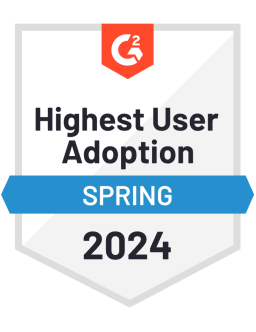Voice of the Customer (VoC) provides an indispensable glimpse into customers' minds that no other data source can provide. It helps you understand their needs, expectations, perceptions, and pain points from their experiences with your brand, wherever they are in the customer journey. Monitoring the latest voice of the customer trends, and always seeking ways to get more from your customer feedback, is essential to inform key decisions better and drive CX success.
Here's a look at five VoC trends you should know in 2021 to help power your CX efforts:
1. Eliminating VoC Data Silos
VoC is a critical ingredient in helping brands gain the elusive complete view of the customer from the beginning to the end of the customer journey. However, these insights can often live within one department.
There may even be multiple VoC programs active across an organization. Forrester predicts that in 2021, companies will reorganize to help eliminate these silos and make it easier to wrangle information from different sources internally. At the same time, the role of Chief Customer Officer and Chief Experience Officer continues to grow as companies try to align their efforts across all departments to elevate CX throughout the customer journey.
Most customers now prioritize experiences when choosing vendors, even ranking it above price and brand, according to a Gartner report. That makes eliminating data silos even more critical and a significant VoC trend to monitor. A couple of ways customer-centric brands do this:
Inject feedback into internal customer experience dashboards: This helps stakeholders stay on top of what customers are saying within the context of their duties and goals.
Integrate feedback with other customer data sources: Injecting it into customer relationship management (CRM), ticket management, and web analytics systems, for example, gives users visibility into how customers feel about your products or services. Plus, it provides greater context into customers' behavior (the why behind the what), leading to better decision-making.
2. Using AI for Real-Time (and Time-Saving) Insights
Artificial intelligence and real time often seem like marketing buzzwords. However, this is for a good reason, especially when it comes to VoC.
Stakeholders today need the right insights at the right time to deliver great CX. Critical decisions depend on having a clear understanding of our customers and their experiences. VoC research helps provide this, and AI is playing a growing role in getting these insights quickly.
In 2020, 50% of organizations leveraged AI in at least one business function, according to a study by McKinsey & Company. One example of how AI is playing a role in voice of the customer research? Text analytics.
Open-ended feedback from surveys, social media posts, and reviews gives insight into how customers perceive your CX in their own words. However, continuously reviewing this feedback can take a lot of time.
That can require accessing your reporting regularly (or exporting your survey responses) and manually sifting through each comment for actionable insights and trends. Not to mention, to flag and escalate feedback to your customer support team that requires immediate attention. Depending on the rate at which you collect responses, this way of analyzing feedback does not scale. In the age of CX, the speed of insights is essential.
AI and natural language processing (NLP) is helping do this heavy lifting. Real-time opinion analytics, where each comment is categorized by topic and sentiment as soon as it comes in, provides real-time insights that empower key stakeholders to act quickly.
3. Filling CX Measurement Gaps With Targeted Surveys
Every experience counts. Customer expectations today are sky-high. Consider how three in 10 customers will leave a brand after one bad experience, according to a PwC survey. In the age of CX, measuring the experience at all touch points in the customer journey is essential.
Companies are turning to micro-surveys to fill in gaps in their CX measurement. These are short surveys designed to collect quick, targeted feedback during or right after key experiences, such as after an interaction with a customer service agent.
Consider a customer who complains to a brand on social media about rude service they received at one of their locations. A micro-survey can come into play like this:
The customer's complaint is escalated internally to a customer service agent. The issue is also flagged to the store manager to take any necessary action.
The agent responds to the customer on social media to acknowledge their complaint and apologize for the incident. They inform them that the company is escalating and addressing the issue. Finally, they offer the customer a coupon for their next purchase.
The agent then shares a micro-survey with the customer to confirm if they feel the company remedied the issue to their liking. It also gauges how the customer perceived the actions taken by the brand.
Triggering targeted surveys based on specific actions the customer takes on the website or mobile app is another way brands fill in CX measurement gaps. This targeted VoC research also helps unlock insights to power other key CX initiatives. That brings us to our next trend...
4. Powering Action Management Efforts
Issues can pop up at any time during a customer's journey. However, quickly addressing these issues can be the difference between whether a customer stays with your brand or not.
In the previous section's example, can the brand risk ignoring this complaint? With switching costs at an all-time low, most customers won't abide poor experiences. Plus, in a world where fully half of US customers would pick word-of-mouth if asked to choose only one source of information, brands can't risk a low net promoter score, let alone unhappy customers dissuading others from doing business with you.
Designing your VoC program to enable quick action is growing more crucial in any successful CX program. Setting up automated workflows to flag and escalate negative feedback to a customer service agent (e.g. within a CRM or ticket-management system) can empower them to act quickly. It can also help with prioritizing to-do items. Plus, agents could determine how they can best address the issue before reaching out to the customer.
Closed-loop feedback initiatives powered by targeted VoC research are helping prevent poor experiences from percolating too long in the customer's mind. More importantly, successfully closing the loop with customers helps salvage poor experiences, save customer satisfaction, and smooth out speed bumps in the customer journey when they occur.
5. Making Surveys More Conversational
If Facebook, Pinterest, TikTok, or YouTube have taught us anything, it's that people crave personalized experiences. An Adobe study found 67% of consumers feel it's essential for brands to automatically adjust content during their digital experience based on their current context.
In this same vein, surveys should feel like a conversation between you and your customers. Making a survey feel responsive to their answers can elevate the survey experience. It can help ensure the questions don't feel impersonal or detached from their current context.
Skip logic and branching is one way to do this. But these techniques rely on how respondents answer close-ended questions. Emerging tech like NLP can extend this capability to open-ended answers, too, helping take the conversational aspect to another level.
Not unlike a customer's experience with an AI-driven chatbot, the survey could leverage NLP to process and categorize open-text feedback as it's entered in your online and SMS surveys in real time. Based on how the open-ended feedback is tagged, skip logic can be programmed to show relevant follow-up questions. The survey now feels like a natural continuation of the open text answer for the respondent.
Providing people with a conversational survey experience tailored to them can go a long way to improving the survey experience and meet their growing expectations for personalized experiences. Emerging tech in VoC provides an answer.
Guiding You Through the Latest Voice of the Customer Trends
Customer feedback provides invaluable insights that drive CX initiatives today and customer experience strategies long-term. Learn how we can help you collect the voice of your customers and take each of the trends above head-on. Request a consultation today.
Editor's Note: This article was originally published on socialbakers.com. Any statistics or statements included in this article were current at the time of original publication.
























